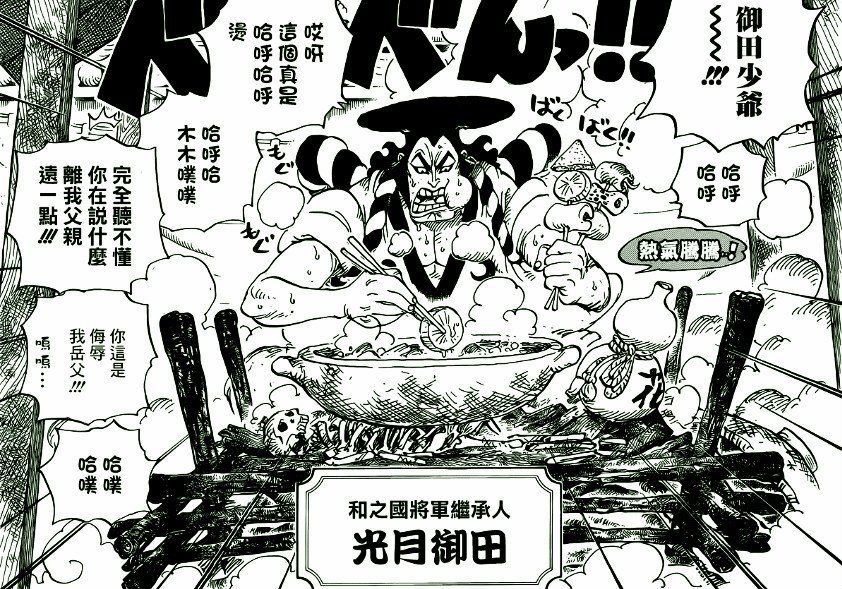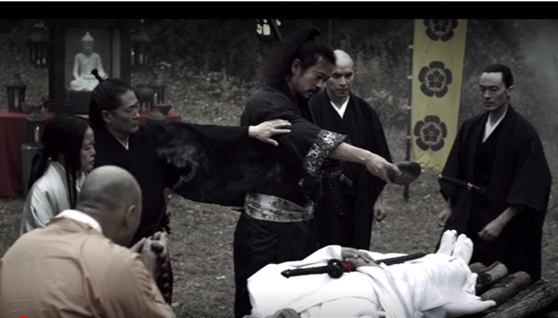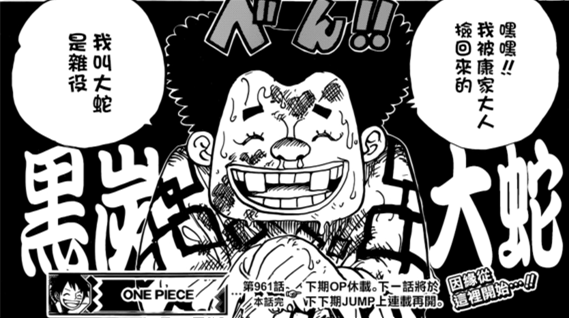Talking about the three heroes of Japan corresponding to [One Piece] and the country: Introduction [Japanese Warring States History] related English words
After One Piece entered the Wano Kingdom chapter, it is full of Japanese elements. Whether it is the painting style of Ukiyo-e, character creation, Japanese traditional music, etc., Oda has adopted a lot of Japanese style and borrowed many Japanese myths and legends. Wano Country is the country of samurai, and it is also a country that has been closed to the country for a long time. In the role of Wano Country, it is obvious that Oda is based on the characters of Japan's Warring States Period. The Warring States Period of Japan was the most colorful era in Japanese history. There were three heroes who made great contributions to the unification of Japan and were called "the Three Heroes of the Warring States Period in Japan", namely Oda Nobunaga, Toyotomi Hideyoshi, and Tokugawa Ieyasu. From the chapter of One Piece and No Country, it can be seen that there are three characters that are roughly based on the three heroes of Japan's Warring States Period. Can sea fans guess which three are they? Today, I will talk about the characters of One Piece corresponding to the three heroes of Japan, and learn some by the way. English words related to the history of the Warring States Period in Japan.

Listen to this article Podcast podcast program to learn English, more program content: https://englishgo.club/podcast/
Kozuki Oden vs Oda Nobunaga
The most legendary character of the Wano country - Kozuki Oden's shocking appearance has caused a lot of controversy. The reason is that as the son of the general of the Wano country, he is completely free from etiquette and causes trouble everywhere. From birth to 18 years old, he has been doing deviant things, and because of this, he has a "notorious reputation". He threw his nurse out at the age of 0, caught a rabbit at the age of 2, killed a bear with a boulder at the age of 4, and visited the flower building at the age of 6. Splurged on the city's reserves. At the age of 8, he was able to fight with alcoholic gamblers. At the age of 9, he was blacklisted by gangsters. At the age of 10, he was arrested for fighting a gangland fire. At the age of 15, he plundered folk women to build a harem. By the age of 18, Oden had failed 38 times in his attempts to "go to sea", but he had not compromised at all. In addition, he cooked oden on the remains of his friends in the crematorium. At first glance, his behavior makes people angry, and is even considered by many netizens as a typical "scumbag", but he has a set of chivalrous principles. The setting of this man, Oda, is a man full of ideal romanticism and uninhibited liberty. If he is MAN enough, he doesn't care about the ethical ethics that bind people at all.

In fact, the prototype of the role of Kozuki Oden is the famous hero of Japan's Warring States Period - Oda Nobunaga. How similar are Oda Nobunaga and Kozuki Oden? First, Oden was often idle and deviant in his youth, just like Nobunaga's unconventional playing cards; second, Oden's cooking oden on the dead body of the crematorium caused controversy, and Nobunaga once threw incense on his father's altar at the funeral, so Challenge the traditional behavior; third, their vision is very broad, Oden dared to break the sea ban in Wano country, and dared to accept new ideas and new things. Innovative policies such as free trade, acceptance of Western culture, and rectification of traffic routes have opened up the road to Japan's modernization; fourth, the nine knights of the red sheath came from humble backgrounds but could become Oden's retainers, and they gathered with Shinchang "the only way". A group of capable people coincides with each other; Fifth, before Oden fulfilled his long-cherished wish of "founding the country", he was burned to death in Oden Castle by his trusted subordinate, General Orochi, and Nobunaga in history was about to complete the eve of national reunification. , was burned to death in Honneng Temple by his cronies Akechi Mitsuhide. This tragic ending of unfulfilled ambitions is very in line with our Eastern definition of a hero, just like Zhuge Liang who died before he was born in Chinese history. Oda Nobunaga was selected by the Japanese people as the "No. 1 Japanese favorite historical figure in 2014".

Black Charcoal Orochi VS Akechi Mitsuhide / Toyotomi Hideyoshi
There may be two prototypes of the role of the black charcoal orochi. The betrayal of the big snake caused the Koyuki family to perish in the fire, and it alluded to Akechi Mitsuhide, who killed Nobunaga in the "change of Honno Temple"; another theory is that Oda Nobunaga's actual successor, Toyotomi Hideyoshi, Historically, Hideyoshi was nicknamed "Bald Rat" and "Monkey" because of his obscene appearance, which matched the image of Orochi, and Orochi's poor life was exactly the same as Hideyoshi's background as a handyman. Orochimaru was originally a handyman picked up by Shuangyue Yasuo's house. He is a very ambitious character who is good at hiding his true thoughts. His ultimate goal is to control Wano, but his strength alone is not enough to do it, so He conspired with Kaido, who wanted to steal history, to take the country of Wano and steal the position of general; and Hideyoshi entered the samurai class by virtue of his military exploits. At that time, Japan was a country with strict hierarchies, and it was almost impossible for civilians to become warrior. The only failure is that after reunifying Japan, he invaded Korea with all his might, causing the headquarters to be severely damaged, but nothing was gained.

Yasuzuki Shimotsuki vs Tokugawa Ieyasu
Judging from the name, Shuangyue Ieyasu (Old Kang) should be a tribute to Tokugawa Ieyasu. The appearance, experience and ending of the two characters are not much similar, but the most similar feature in character is "forbearance".
Sun Tzu once said, "A soldier is a deceitful way. Therefore, he can show what he can't do, and when he uses it, he shows what he does not use." In this trick, the main emphasis is on "the art of concealment", the purpose is to hide the true strength or hide the unrecognizable information, and even disguise one's "strength" as "weakness", making it difficult for the enemy to distinguish.
The Yasuzuki family is the only daimyo left to serve Koyuki, and it is also the power with the strongest samurai group. Although the country of Wano has been occupied by the generals Orochi and Kaido for 20 years, the Yasuzuki family has been successfully hidden in Ebisu Village for many years. Still one of the most influential figures. After the anti-Crescent symbol was exposed, the anti-Orchid companions were arrested one after another, so the Shuangyue Yasushi family was deliberately arrested, knowing that his death would inspire more people to fight against the general Orochi, and finally the public riots did make Wano Kingdom very chaotic , distracting Orochi and Kaido from suppressing.

The same kind of compassion, Tokugawa Ieyasu was taken as a hostage by Imagawa Yoshimoto at the age of six, and he endured humiliation and humiliation for twelve years. During the alliance, Ieyasu was forced by Nobunaga to kill his wife and son to gain his trust. After Nobunaga was betrayed by Akechi Mitsuhide, Ieyasu quickly organized an army to annex the countries, but was taken first by Toyotomi Hideyoshi, and had no choice but to surrender to him again. Later, Hideyoshi, who unified the world, died of illness, and Ieyasu seized the opportunity in one fell swoop to settle the power of Toyotomi Hideyoshi and take the world into his pocket. He was the ultimate winner of Japan's Warring States Period. A few years later, Ieyasu was awarded the title of Great General for Conquering Barbarians by the Emperor of Japan. In the same year, he moved the capital to Edo and established the Tokugawa Shogunate. Japan entered three hundred years of peaceful and stable development.
English words related to the history of warring states in japan
Sengoku period/Warring states period Sengoku period: is an important period in Japanese history, generally refers to a period of more than 120 years of political turmoil and separatist rule starting from the Onjin Rebellion during the Ashikaga Yoshige period in 1467.
samurai samurai: After the Dahua reform (ninth century), the nobles and temples opened up new land and needed the protection of the samurai, and the samurai was born. Bushido is the moral code and philosophy of the samurai class in Japanese feudal society. Just like the chivalry that appeared in the Middle Ages in Europe.
ninja ninja: It is a time of chaos. Ninjas have different fighting skills than samurai, and because of this, they are the best choice to protect important people. In addition to protection, they also perform some special tasks, such as: assassinating the opponent's generals, inquiring about intelligence, etc. .
shogunate shogunate: The shogunate refers to the samurai regime that was led and ruled by the Great General Zhengyi in Japanese history. shogun shogun of the shogunate era, also known as warlord dictator
feudal period Feudal period: Japan's feudal system originated from the legal system of the Heian period from the 8th to the 12th century, became the mainstream system during the period of the samurai regime from the 12th to the 19th century, and ended with the Meiji Restoration in the second half of the 19th century.
Seppuku/hara-kiri Cut the abdomen: mainly practiced by the Japanese samurai, in Japanese culture, cut the abdomen as a dignified death method honorable ritual suicide.
clan clan: In ancient times, ordinary Japanese did not have surnames. Only blood relatives of the imperial family or loyal ministers of the imperial court had surnames given by the emperor.
faction A faction within a political party, organization, etc.
As a country based on Japan, it is not surprising that the country of Wano is based on the famous Three Heroes of the Warring States Period. Kozuki Oden, who is based on Oda Nobunaga, is deviant and talented; Charcoal Orochi, from humble beginnings but with great ambitions, succeeded in winning the world; the Yasuzuki family, based on Tokugawa Ieyasu, endured humiliation and took the world into his pocket, looking forward to the development of the next episode of One Piece and the Kingdom of the Kingdom. In addition, friends who like the history of Japan's Warring States period can also watch the Netflix series "The Age of Samurai: The Fight for Japan".
If you like my article, or feel that it is helpful to you, please help me like it below and share it. Your support is the driving force of creation. You are also welcome to follow the takeaway English site , FB or IG . Thank you for your support 😊!
Like my work? Don't forget to support and clap, let me know that you are with me on the road of creation. Keep this enthusiasm together!

- Author
- More